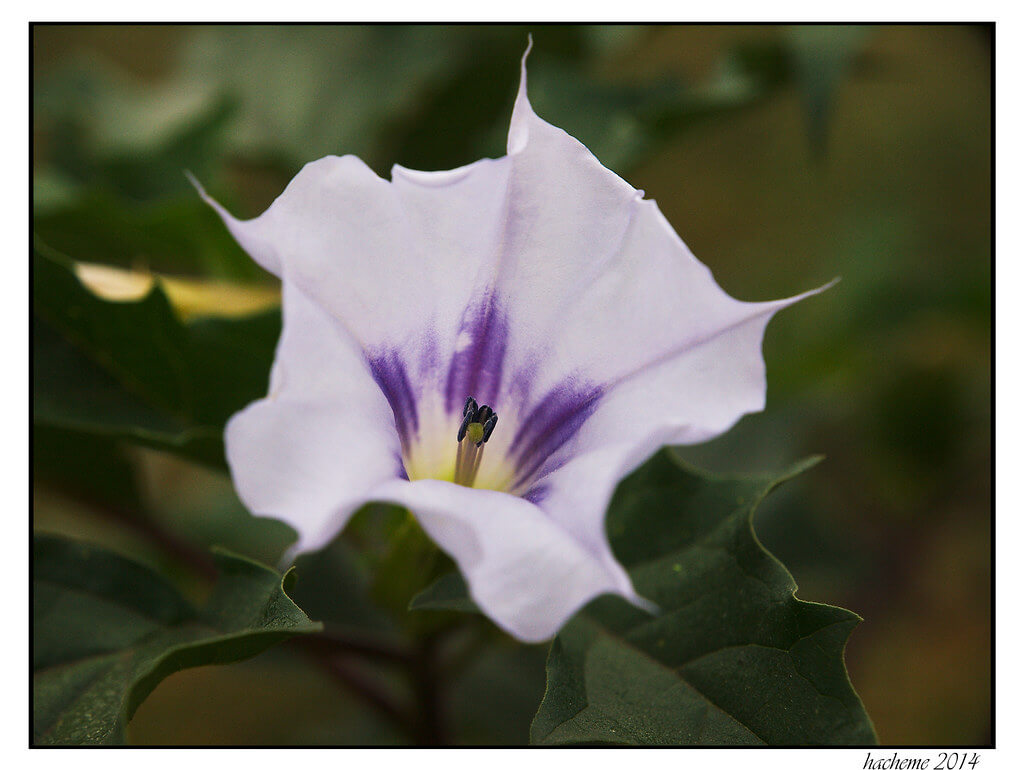What Does It Look Like?
What is it?
Leichhardt's Thornapple (Datura leichhardtii) is a much-branched, robust, bushy, annual plant that grows to 1.2 m high but may flower when only 0.1 m high. The branches are green. The leaves are alternately arranged along the stem, stalked, bright green, broadly trowel-shaped to oval, mostly 50-70 mm long (sometimes up to 80 mm) and 20-45 mm wide. The leaves have several short, broadly triangular, angular or rounded lobes along each margin, all of similar size.
The flowers are borne singly in the branch forks; they are shortly staked, 45-70 mm long, white, cream or faintly rose-tinged towards the top, with 5 short, broad lobes each ending in a narrow tip. There is a tubular, green calyx (outer covering) extending for about half the total flower length from the base; it is rounded and 5-toothed.
Leichhardt's Thornapple has capsular, prickly fruits, that bend downwards. At maturity, the fruit-body is globular, sometimes broadly egg-shaped, 20-25 mm long and has very numerous slender prickles of uneven length all distributed evenly, the longer ones 4-9 mm long. The capsules break up unevenly or may partly open up evenly into 2 or 4 segments initially, usually then further breaking unevenly, shedding a large number of seeds. The seeds are more or less ear-shaped, markedly narrowed towards the base, finely pitted, light brown to grey-brown, 4-4.8 mm long ( Haegi 1976; Purdie et al. 1982).
For further information or assistance with the identification of Leichhardt's Thornapple contact the herbarium in your state or territory.
Flower colour
White or white with rose tinting
Growth form (weed type/habit)
Much-branched, robust, bushy, annual herb.
Where it currently grows? Preferred habitat
Leichhardt's Thornapple is naturalised in parts of semi-arid, arid and subtropical Australia. It prefers open disturbed habitats such as dry watercourses, stream banks and floodplains and roadsides where there is run-off, but sometimes (especially in Queensland) grows in open grassland on heavy clay soils (Haegi 1976).
Are there similar species?
Leichhardt's Thornapple can be distinguished from all other Thornapples except Fierce Thornapple (D. ferox) by its short flower which is only 40 to 70 mm long. Fierce Thornapple has flowers of a similar size but it has an angular calyx (lower outer covering), its fruit are held erect on the plant, and have only 40 – 60 stout prickles per fruit, the longer ones 15 – 25 mm long; in contrast, Leichhardt's Thornapple, has a smooth, rounded calyx, and capsules with numerous fine prickles, the longer ones only 4 – 9 mm long. (Haegi 1976; Purdie et al. 1982).















